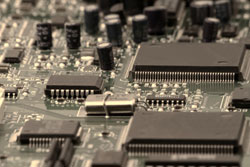Cooler conditions for ceramic sintering
One of the means that advances can be made in the electronics industry is to reduce processing temperatures involved with functional materials. As part of their aim, the EC funded project TUF worked on developing new materials for dielectric resonator filters which possess extremely low dielectric loss. Project partners at the Josef Stefan Institute in Slovenia specifically chose to investigate low-temperature sintering to improve productivity costs. Sintering is the process whereby a powder material is heated below its melting point until the particles adhere to each other. Previous to this piece of research, the mechanisms underlying this were poorly understood and a set of basic principles had to be applied for each specific material. Sintering was carried out using barium titanate (BaTiO3) powders with lithium oxide as a sintering aid. Microstructural investigations revealed the presence of two secondary liquid phases. During their investigation of this phenomenon, the scientists discovered that there were several process features or stages that would facilitate sintering. These included melting of one of the reagents, structural vacancies in the matrix and increased solubility of the matrix phase. Results also showed that sintering aids must be selected carefully to minimise their influence on the ceramic's properties. The commercial success of these results can be transformed into a saving in energy costs and or reduction in costs due to materials. For example to achieve the desired dielectric properties, expensive palladium in electrodes of the X7R capacitor was rendered unnecessary due to the consequent reduction of almost 200°C sintering temperature. The reduction of operating temperatures coupled with an understanding of the physical and chemical mechanisms will no doubt continue to form the basis of future work on electro-ceramics for tuneable microwave applications. For further information on relevant articles and papers given at the London South Bank University, access the TUF website at http://ecce1.lsbu.ac.uk/research/pem/index_files/TUF%20papers.htm



